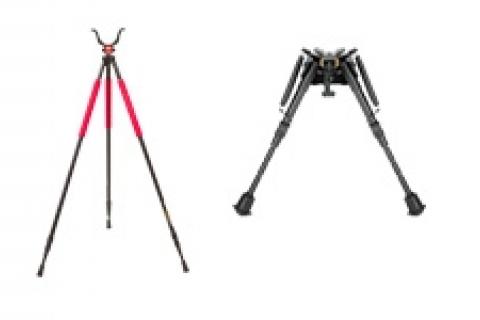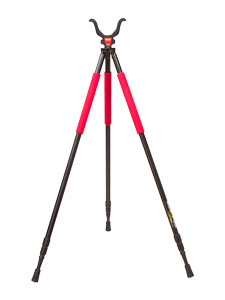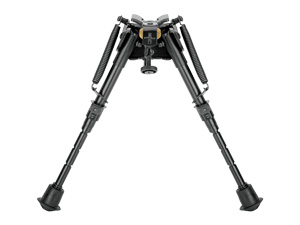
We all know that shooting from the offhand position is very unstable, and that we should try to avoid it. Some of us have actually gotten pretty good at getting in the habit of trying to get down lower for a kneeling or sitting shot, or looking for a tree, fence or rock to lean on whenever possible. But when there isn't anything like that close at hand, we still tend to blaze away from a standing position, and even if we are able to get down for a kneeling or even sitting shot, it's not always very stable. There is an answer: shooting rests.
 |
| While shooting tripods may be heavier, they provide a steadier shot. |
I fell in love with shooting rests a few years ago while on my first safari to Africa. They are commonly used on the Dark Continent because tall grass usually prevents a hunter from getting down low for a steady shot, and there isn't always a tree or termite mound handy. I used a set of wooden shooting sticks to take animals at nearly 300 yards, from a standing position; something I could never have done without the aid of a shooting rest. I decided then and there that I would use them a lot more often back home too, but I also knew that I wanted something a little more versatile than wooden sticks. If you too have realized the benefits that shooting rests offer and are looking to add one to your hunting essentials, here's what you need to know.
All shooting rests are either monopods (one leg), bipods (two legs) or tripods (three legs). Obviously the more legs the rest has, the steadier it will be but, as with most things in life, "better" comes at price, in this case in the form of added weight and cost. Shooting rests for field use come in two basic varieties: something that attaches to your gun, or something that you carry separately. Let's look at the benefits and features of both.
Shooting Rests That Attach
Shooting rests that attach to your gun are usually monopods or bipods, and either attach to the front sling swivel stud of a rifle, or to the underside of the barrel of a shotgun. They are adjustable in length, and can usually be used from the prone to sitting or even kneeling positions. Although they don't usually have the ability to swivel or rotate, some can pivot to allow for uneven ground. The advantage of these rests is that they are always close at hand when needed, instead of forgotten back in the truck. Their drawback is perhaps a lack of versatility, and the lack of a third leg. The ones that attach to the sling swivel stud of a rifle are popular for hunting a variety of prairie or plains game such as pronghorn, mule deer, caribou, coyote and varmints, where trees are often scarce but where the cover usually allows the shooter to get down fairly low to the ground. Those that attach to the barrel, meanwhile, are popular with turkey hunters.
Detached or Stand-Alone Shooting Rests
Stand-alone shooting rests are carried separately from your firearm and are quickly deployed when needed. Several different versions and styles are available in monopod, bipod or tripod configurations. All are quickly adjustable for height, sometimes ranging from prone to standing positions, usually by way of either twist locks or lever locks on the telescoping legs. Most such rests feature one or two U- or V-shaped rests, or yokes, on top of the rest, which holds your gun (or even crossbow) stead. Some even rotate 360 degrees, and offer such niceties as camouflaged finishes and rubberized coatings for stealth, carbide-tipped legs for slippery surfaces, inch markings on the legs for precise settings, and a carry bag for convenience and protection from the elements. Some lightweight bipods have folding legs instead, and utilize a non-rotating "scissor" V-rest. Standalone shooting rests are a popular choice for a variety of hunting situations, ranging from sheep and goat in the mountains, to bear and deer in the lowlands.
 |
| If hunting in the mountains, a bipod (shown) or monopod are lighter and more portable to carry. |
Certain standalone shooting rests offer the versatility of quick-change interchangeable heads to fit video cameras, still cameras, spotting scopes and even binoculars, so you can go from using them to glass an elk on a ridge to using them to drop that same elk in his tracks in just a matter of seconds. This is particularly handy if you are a photographer as well as a hunter; you no longer have to carry a separate camera tripod to take high-quality photos of your trophy, as that same shooting rest can quickly change to camera tripod.
So Which Shooting Rest is Right for You?
That depends on what type of hunting or shooting you are going to use it for the most. As mentioned before, the more legs a shooting rest has, naturally the steadier it will be. But an extra leg or two adds some cost and weight. If you're sitting in a ground blind all day, the extra weight probably won't mean anything to you, but if you are on a high-mountain sheep hunt where you need to carry everything on your back and every ounce counts, it probably will. Similarly, if you are hunting coyotes on the prairies, you can benefit from a shooting rest with three legs that can be spread out wide to give a solid base, but if you are hunting whitetails in a small pop-up ground blind, you may not have room for something with three legs, and a bipod or monopod might be a better choice. Overall, tripods tend to be a bit more versatile, as you can usually strap two or even all three legs together to make it into a bipod or even a monopod (or walking stick!), when the situations calls for it.
Whatever choice you make, you will soon realize what you've been missing all these years, and wonder why you didn't make the move sooner.
- 8062 views

